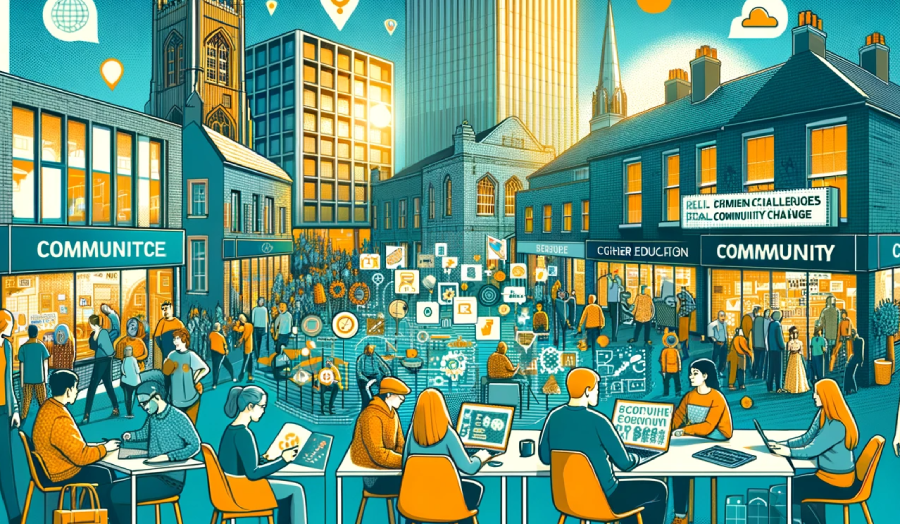What is the challenge and context?
In academic year 2021/22 as a response to the pandemic, the Interior Design course developed an innovative opportunity to engage students to work on a studio design project addressing a real-world scenario/challenge within the local community. The project brief was to devise a design proposal for a “community library” considering the needs and requirements of local young people as end-users post pandemic. The project’s aims were to build students’ confidence (post covid) through meaningful collaborations with their peers, members of staff, mentors, and end-users of their ideas, which were Year 9 & 10 pupils from a local School in Tower Hamlets. The approach was framed around celebrating and enhancing the student experience within the classroom underpinned by learning theories foregrounding connections of learning, experimentation, testing and innovation through individual and group work activities. It was further important to consider the cohort’s predominantly online learning student experience so far (post covid) and address this with a meaningful course related engagement project as well as having an impact on those who participated as end-users and other local stakeholders.
What did we do?
The project was anchored in and part of a Level 5 module which kicked off at the start of term involving 5 teaching weeks of preparatory sessions with students and project planning throughout, culminating in a one-day workshop event delivered in teaching week 6. The project event involved students, staff, school pupils, and external stakeholders (industry mentors). However, students played the key role as they planned, organised and delivered the workshop event. The inclusive approach is characterised through important elements to achieve learning outcomes. The most important ones are listed and elaborated below:
- Students as Partners: Students engaged with learning & behavioral theories, approaches to undertake primary research and exchanged ideas to develop a strategy to gather feedback from participants to allow for a participatory, co-constructed design approach
- Facilitating active learning opportunities: group & project work, research based learning and collaborative activities
- Real-world scenario/challenge: students’ knowledge and lived experiences woven into developing solutions to address challenge
- Learning environment: multi-modal learning activities and co-creation opportunities to strengthen sense of belonging and create community
What happened? or what was the impact?
The cohort of students who took part in the intervention reported several academic and personal benefits gained through participation. Students’ testimonies emphasise the impact organised across three key themes below:
- Critical reflection/thinking skills: “Having local students in really brought an awareness of who we were designing for right from the beginning” & “This experience definitely enabled us to push the boundaries and create more exciting, tailored and inclusive designs.”
- Collaboration & group facilitation skills: “For a project with a demographic that was solely local school students, the opportunity to connect with this specific group of people was extremely useful. Being able to really understand the user of the space you are designing is vital, and it is not always possible to directly meet and really get to know the needs of the user. So, when the students came in to listen to us present, and then later answer our own questions, it really helped us all develop our concepts”
- Presentation & Employability skills: “The preparatory research required to make a presentation, present it and then work with the students, helped to gain a good insight into what it will be like to work as a professional interior designer” & “The opportunity to present to this large group of people was great for us in terms of preparing for our careers.”
Could the practice change be rolled out more widely?
Principles and learning opportunities highlighted through this practice example can be adapted and replicated across a variety of disciplines and learning contexts. This can happen alongside the formal curriculum to boost professional skills and enable students to become responsible citizens and consider implications of their own learning journey (within their relevant subject discipline) for a more sustainable future.

Academic Leads: Janette Harris (Course Leader Interior Design) & Kaye Newman (Head of Design and Interiors)
School: Art, Architecture and Design
Subject area: Design & Interior Design
Key links
Presentation slides about project presented at Learning and Teaching conference (2022)
Student as Partners (SaP): Student Partnership Agreement at London Met & SCP example experiences
Bhagat, D & O’Neill, P (2011) Inclusive Practices, Inclusive Pedagogies: Learning from Widening Participation Research in Art & Design Higher Education CHEAD/ Ukadia Croydon
Gramatakos, A.L. and Lavau, S. (2019), "Informal learning for sustainability in higher education institutions", International Journal of Sustainability in Higher Education, Vol. 20 No. 2, pp. 378-392.
UPP foundation (2022): A Student Futures Manifesto - Final report of the Student Future Commission
